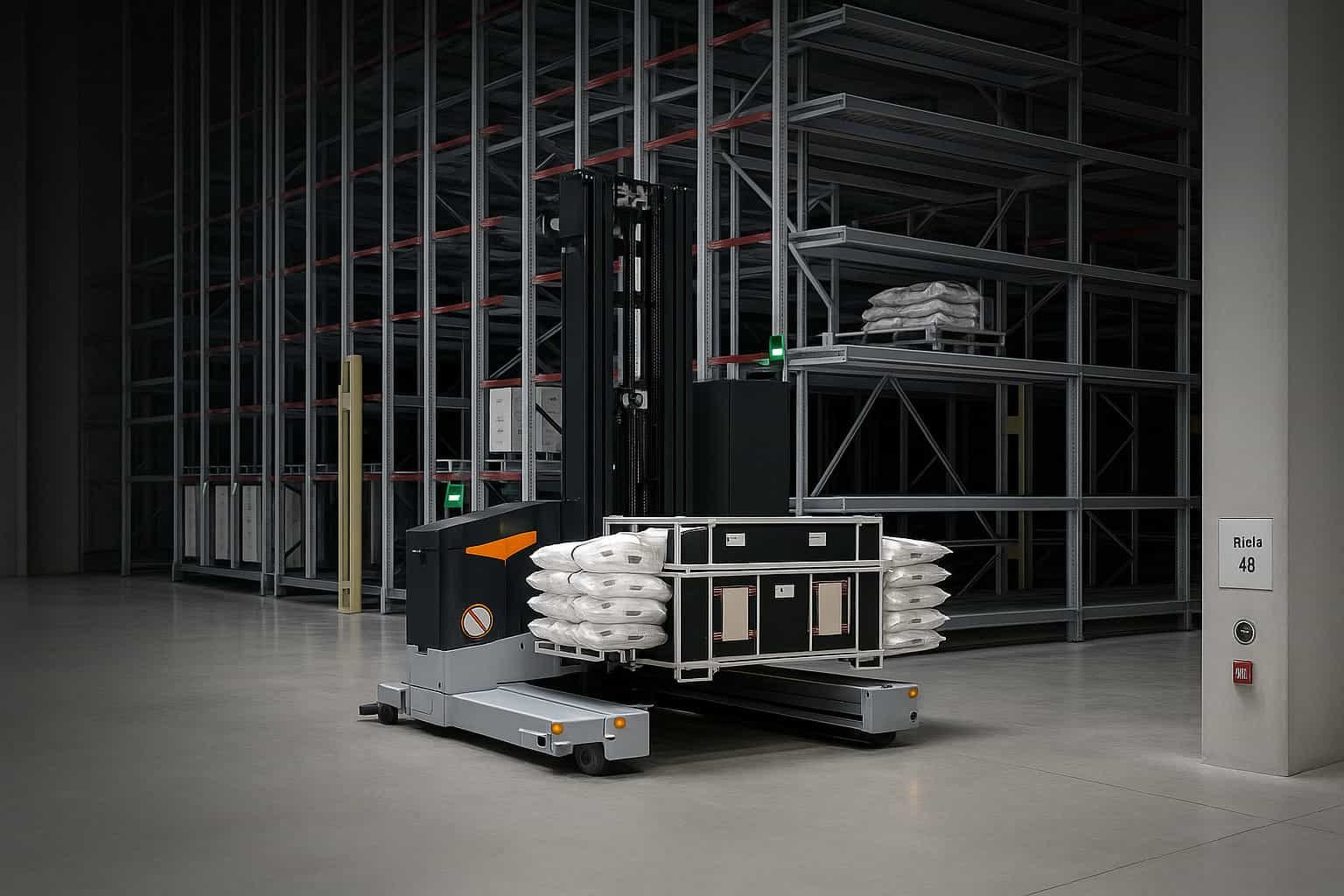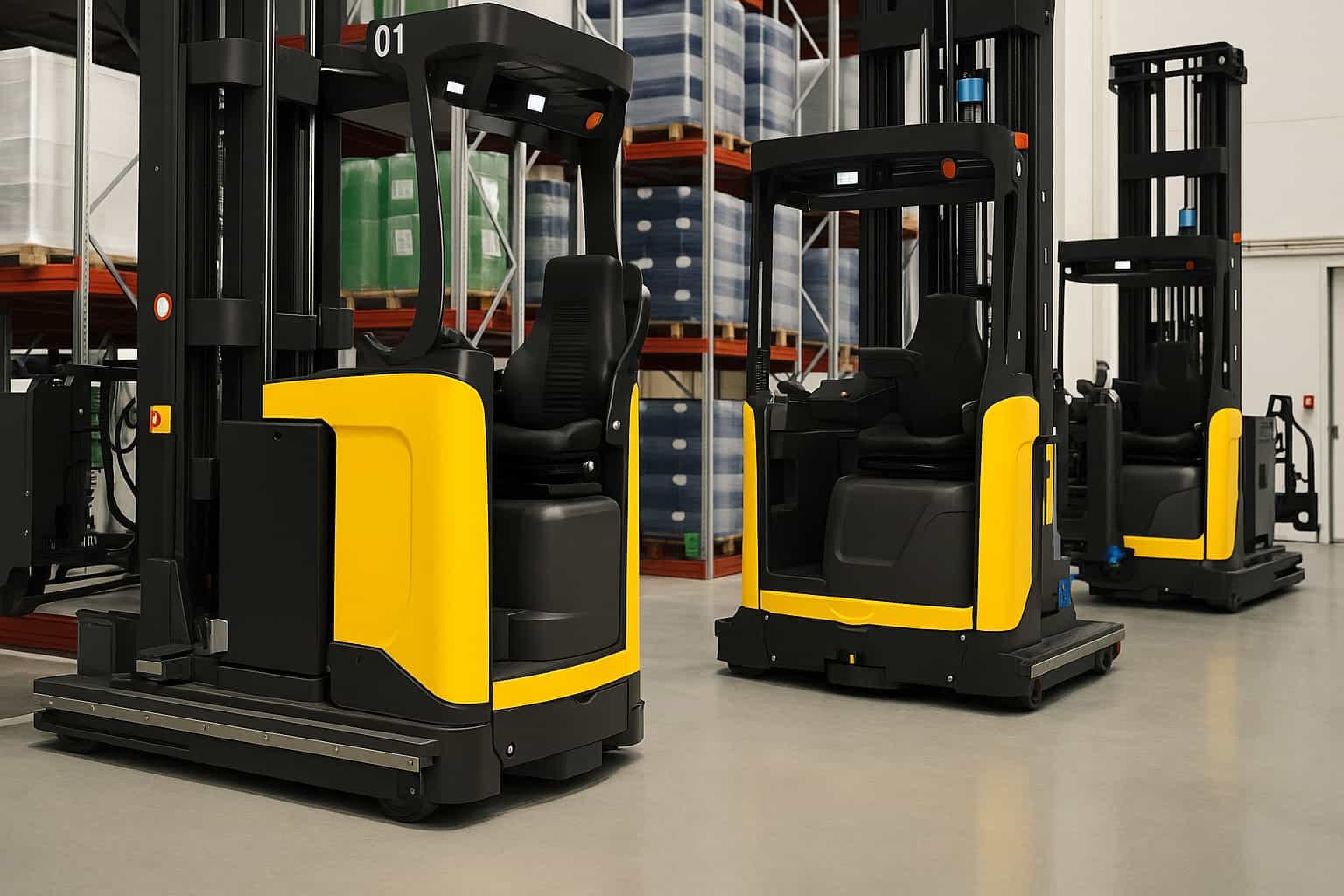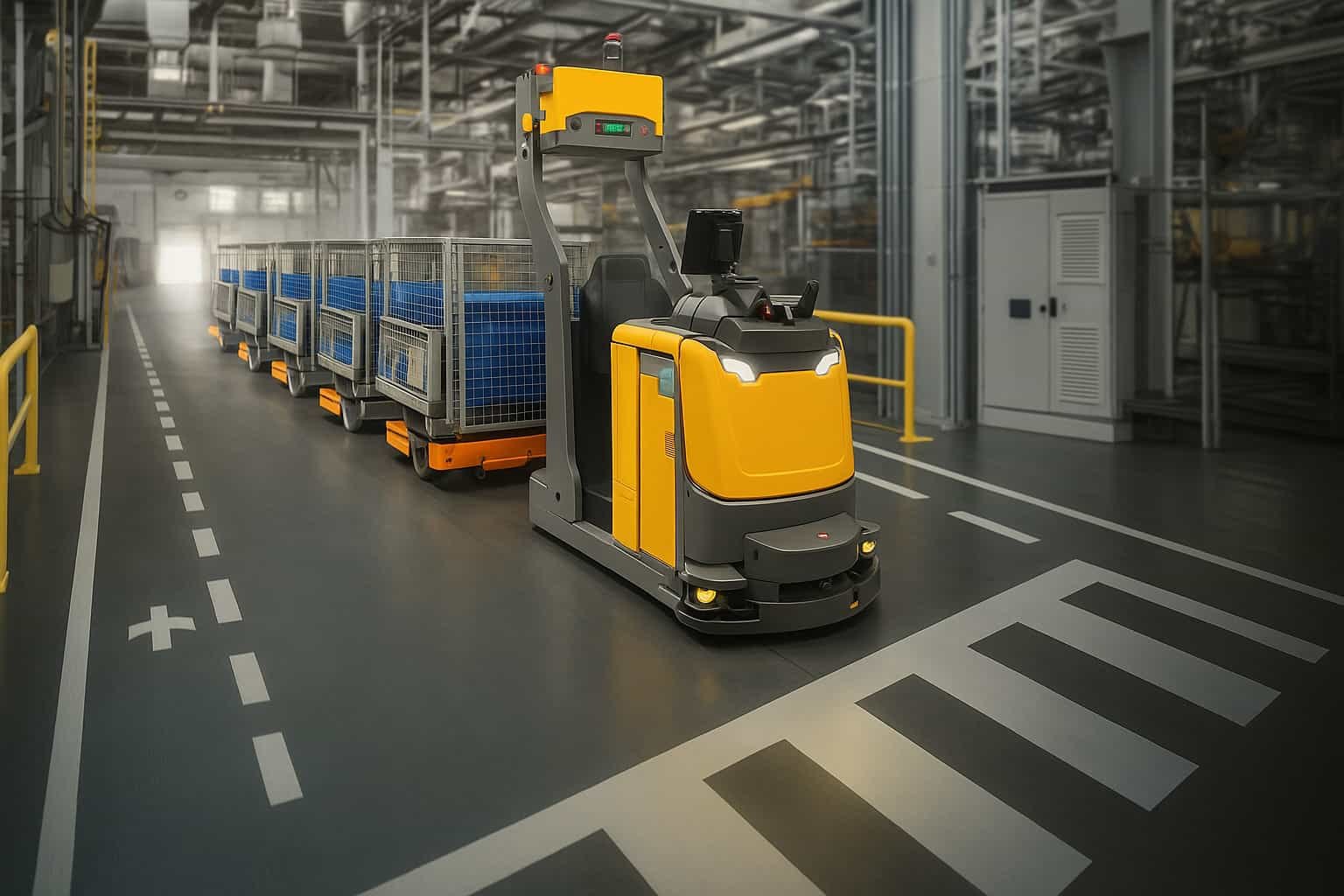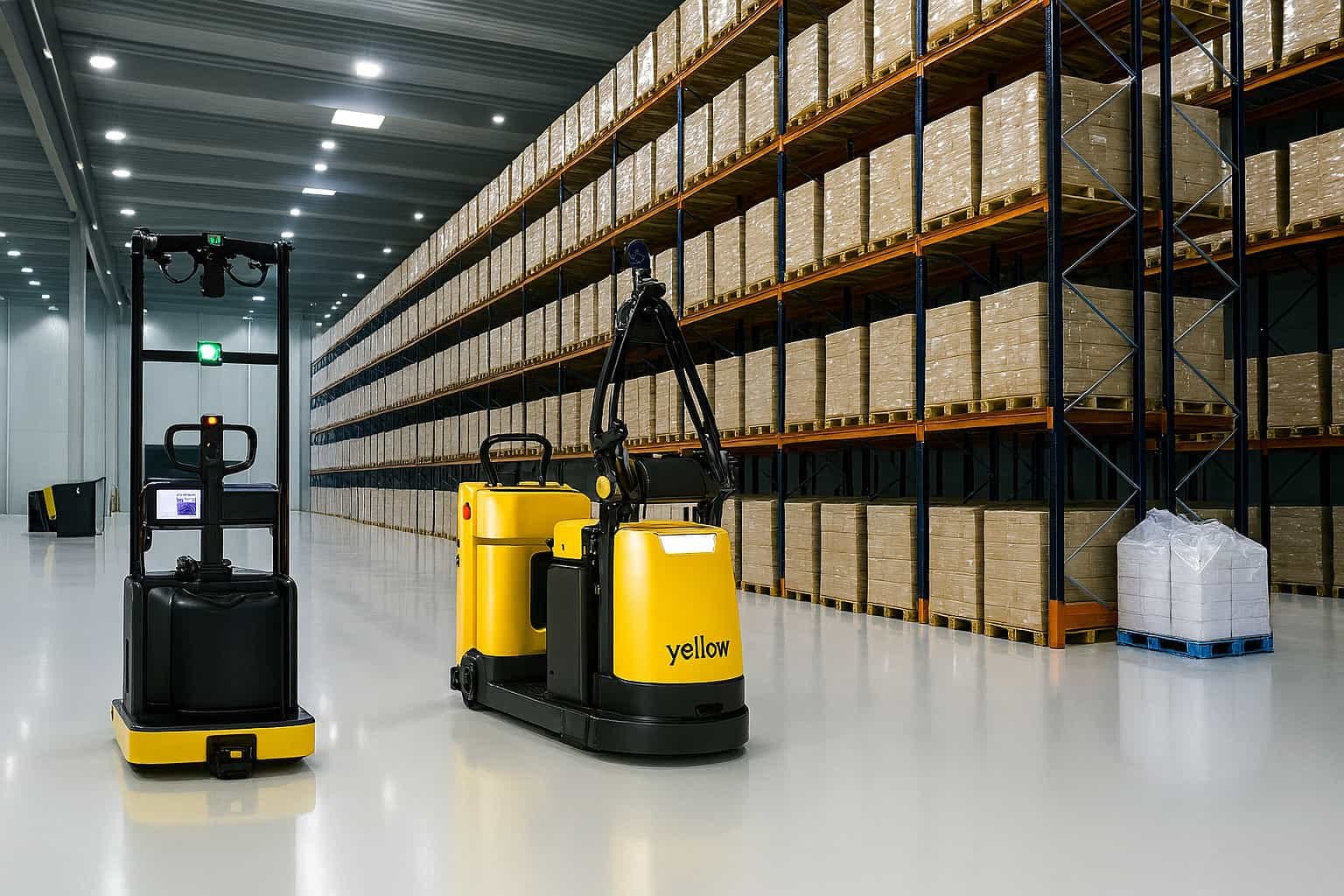What is Forklift AGV?
A Forklift Automated Guided Vehicle (AGV) is a type of automated machine designed to transport materials within a warehouse or manufacturing facility without human intervention. These vehicles follow predefined paths using various navigation technologies such as laser guidance, magnetic tapes, or optical sensors.
Key Features of Forklift AGV
- Navigation: Uses laser guidance, magnetic tapes, or optical sensors.
- Automation: Operates without human intervention.
- ความปลอดภัย: Equipped with sensors to avoid collisions.
- Efficiency: Increases productivity by reducing manual labor.
How Forklift AGV Works
- Path Planning: Predefined routes are set up in the facility.
- Navigation: The AGV follows these routes using its navigation system.
- Material Handling: Automatically picks up, transports, and places materials.
- ความปลอดภัย Protocols: Sensors detect obstacles to prevent collisions.
Forklift AGVs enhance operational efficiency and safety in industrial environments by automating material handling tasks.
What is the difference between AGV and LGV?
Automated Guided Vehicles (AGVs) and Laser-Guided Vehicles (LGVs) differ primarily in navigation technology. AGVs use predefined paths, often marked by magnetic strips or wires, while LGVs use laser sensors to navigate dynamically within a space.
Key Differences:
- Navigation Method:
- AGV: Utilizes fixed routes like magnetic strips, wires, or visual markers.
- LGV: Employs laser sensors for flexible navigation and obstacle detection.
- Flexibility:
- AGV: Less adaptable to changes in the environment; requires physical alterations for route changes.
- LGV: High adaptability; can modify paths in real-time without physical changes.
- Implementation Cost:
- AGV: Generally lower initial setup cost due to simpler technology.
- LGV: Higher initial investment but offers greater long-term flexibility and efficiency.
Understanding these differences helps in choosing the right system based on operational needs, scalability, and budget.
What does AGV mean in logistics?
An Automated Guided Vehicle (AGV) in logistics refers to a type of robot used for material handling in warehouses and factories. AGVs autonomously transport goods without human intervention, enhancing efficiency and reducing labor costs.
Key Features of AGVs:
- Navigation Systems:
- Laser Guidance
- Vision Guidance
- Magnetic Tape Guidance
- Primary Uses:
- Material Transport: Moving goods between locations.
- Inventory Management: Assisting in stock replenishment.
- Order Fulfillment: Picking and packing items for shipment.
Benefits of AGVs:
- Increased Efficiency: Continuous operation without breaks.
- ความปลอดภัย: Reduced risk of workplace accidents.
- Cost Savings: Lower labor costs and reduced product damage.
AGVs are integral to modern logistics, providing reliable and efficient automation solutions.
What are the Advantages of Forklift AGV?
Forklift Automated Guided Vehicles (AGVs) offer several key advantages, including increased efficiency, safety, and cost savings. They automate material handling processes, reducing the need for human intervention, and minimizing errors and accidents.

Key Advantages
- Increased Efficiency:
- Continuous Operation: AGVs can operate 24/7 without breaks.
- Precision: Accurate movement and placement of goods.
- Enhanced ความปลอดภัย:
- Reduced Human Error: Automation minimizes the risk of accidents.
- Sensor Integration: AGVs are equipped with sensors to avoid collisions.
- Cost Savings:
- Labor Costs: Reduction in manual labor leads to lower operational costs.
- Maintenance: Lower maintenance costs compared to traditional forklifts.
- Scalability:
- Easy Integration: AGVs can be easily incorporated into existing systems.
- Flexibility: Adaptable to various warehouse layouts and tasks.
By leveraging these advantages, businesses can improve their operational efficiency and safety while reducing costs.
The Difference Between Low-Profile AGV and Forklift AGV
Low-profile AGVs and forklift AGVs differ primarily in their design and operational use. Low-profile AGVs are compact and typically operate underneath loads to lift and transport them, while forklift AGVs are designed to handle pallets and heavy loads, operating similarly to traditional forklifts.

Key Differences:
- Design:
- Low-Profile AGV: Compact, flat design that maneuvers under loads.
- Forklift AGV: Larger, vertical structure with forks for lifting pallets.
- Load Handling:
- Low-Profile AGV: Lifts loads from the bottom.
- Forklift AGV: Lifts loads using forks, similar to a manual forklift.
- Applications:
- Low-Profile AGV: Ideal for assembly lines and tight spaces.
- Forklift AGV: Suitable for warehouse operations and heavy-duty tasks.
- Navigation:
- Low-Profile AGV: Often uses magnetic tape or QR codes for guidance.
- Forklift AGV: Typically equipped with advanced sensors, LiDAR, and vision systems for navigation.
In summary, the choice between a low-profile AGV and a forklift AGV depends on the specific requirements of the operation, including load type, space constraints, and navigation needs.
How to Choose the Right Type of AGV?
Selecting the right Automated Guided Vehicle (AGV) involves understanding your specific operational needs and assessing various AGV types. Key factors include load capacity, navigation technology, and integration capabilities with your existing systems.

Key Considerations:
- Load Capacity: Determine the weight and size of loads the AGV needs to transport.
- Navigation Technology:
- Laser-Guided: Uses lasers for precise navigation.
- Magnetic-Guided: Follows magnetic strips on the floor.
- Vision-Guided: Employs cameras and sensors for flexibility.
- Integration: Ensure compatibility with current warehouse management systems (WMS) and other automation technologies.
- Environment: Assess the operating conditions, such as indoor/outdoor use and temperature ranges.
- Flexibility and Scalability: Choose an AGV that can adapt to future changes and expansions in your operations.
By thoroughly evaluating these factors, you can select an AGV that enhances efficiency and aligns with your operational goals.


